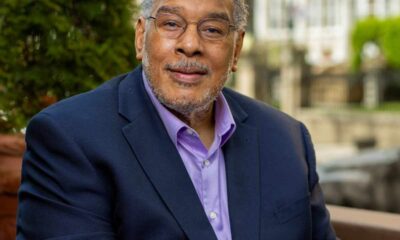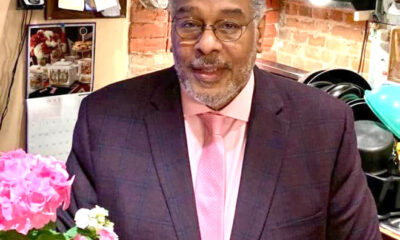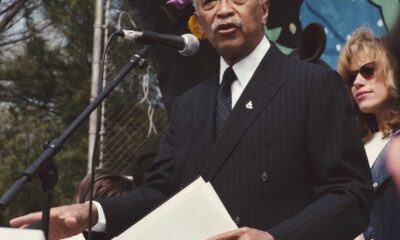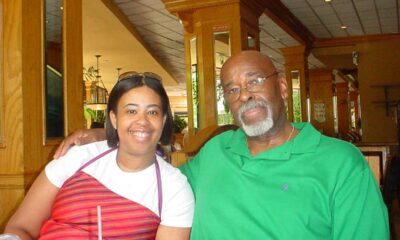Community News
Remembering the Life of Dr. John Flateau
A Beloved Friend and Political Ally
By Roger L. Green
As I reflect on the distinguished life of my beloved friend and political ally, John Flateau, I’m moved to recall and celebrate the charge that the late Ozzie Davis presented to the Congressional Black Caucus in 1981.
Davis, an “activist artist” who prioritized “innertainment” before entertainment, articulated this illuminating insight for the African American body politic and our larger community when he charged:
“It’s not the man, It’s the plan, it’s not the rap, it’s the map”
To be certain, the life of the indomitable John Flateau validated a typology of leadership that embraced this important charge.
Through Dr. John Flateau’s public service, our community could touch and see a unique role model who processed an unbending discipline that enabled him to “dot the I’s and cross the T’s” in pursuit of a form of community empowerment and democratic self-governance that would transform for the better the citizens and denizens who originate from the African diaspora and a larger community of color.
In fact, Dr. Flateau was a penultimate scholar-activist who consistently harnessed his exceptional intellect to challenge the structural racial and economic inequality that continues to challenge our community.
Allow me to present a few examples of my late friend’s extraordinary public service that contributed to empowering our community and enhancing equal justice and democratic self-governance throughout New York State:
A Legislative Professional
John was the first executive director of the New York State Black and Puerto Rican Legislative Caucus. While serving in this position, he provided a sterling example of the professionalism and legislative mastery that benefited me and other members of the state Assembly and Senate.
Numerous laws, policies, and funding opportunities were directed to our Communities of Color because of John’s commitments.
The Proponent of Economic Democracy
John’s legislative achievements eventually paved the way for his appointment as the Deputy Director of the New York State Economic Development Corporation. During his tenure in this position , John collaborated with Michael Nairne, Audrey Bynoe, and me as we orchestrated the enactment of the first state laws, policies, and programs that provided affirmative opportunities for the minority business community.
An Advocate For Voter Rights
Before reaching the ripe old age of 29, John aligned with attorneys Esmerelda Simmons, Paul Wooten, and Assemblyman Albert Vann to initiate a scholarly, legal, and legislative strategy that transformed the inequitable and anti-democratic structure of a New York City and state government that contributed to marginalizing the political representation of Communities of Color.
John was the lead plaintiff in a case entitled Flateau v Anderson. As a result of his vision and tireless support for representative democracy, the governance and body politic of our city and state are mostly informed by the values inherent in the historic Civil Rights Act of 1965 and the principle of 1 person, one vote.
To be certain, the unprecedented number of contemporary elected officials originating from Communities of Color can , in part, trace their ascension to this tenacious organizer, whom his allies affectionately entitled, “Map Man.”
Anchoring the Dinkin’s Administration
In 1990, John joined Albert Vann and me as we crossed the Brooklyn Bridge to convince a Harlem elected official named David Dinkins to enter a campaign to become the first African American mayor of New York City.
Our Brooklyn delegation had to ensure Borough President Dinkins that he would secure support from the Coalition for Community Empowerment (A progressive cohort of African American elected officials) during this anticipated campaign.
After Dinkins entered the campaign for mayor, John, the ultimate organizer, would collaborate with a “rumpled genius” named Bill Lynch to guide David Dinkins to a historic victory.
Following this monumental electoral victory, John would serve as David Dinkins’ accomplished Chief of Staff. This public service assignment was another first for the African American community and another example of our brother’s groundbreaking commitment to public service.
Inspiring A New Generation of Scholar Activist
In time, this esteemed community empowerment activist would embrace his academic aspirations when he found a second home at Medgar Evers College. While serving in this learning domain, he would unite with Dean Richard Jones as they worked to cultivate a new generation of civic-minded scholar-activists. As a result of Dr. Flateau’s educational ethic , a growing number of graduates originating from Medgar Evers College became distinguished public servants within federal, state, and city governance.
A Celebrated Thought Leader
Dr. Flateau’s career included his distinguished leadership of the DuBois – Bunche Center for Public Policy, an institution that served as a platform for the numerous studies and books that he authored. His Magnum Opus is a book entitled BLACK BROOKLYN: The Politics of Ethnicity, Class, and Gender. This scholarship provided a comprehensive history of Brooklyn’s Black body politics, a civic infrastructure that he contributed to seeding and building when we were young men.
An Enduring Model for Community Empowerment
A few days before John transitioned to become a sacred ancestor, I had an opportunity to communicate with him as we participated in one of our periodic phone calls. Recently, these lengthy discussions would serve as a rite of passage, a time when we would share updates about our families and friends while envisioning new goals that we might undertake as we entered our eco-careers. To this end, we proposed organizing an event on the birthday of Dr. W.E.B. DuBois that occurs during Black History Month. We hoped that this gathering would encourage a network of students and youthful organizers to envision the benefits that originate from an enduring struggle for community empowerment and democratic self-governance.
Consistent with his disciplined history, John asked: Ok, my brother, who will plan and organize this idea?
Again. “It’s not the man, it’s the plan. It’s not the rap, it’s the map”
Rest in peace and power, Dr. John Flateau. You have bequeathed a progressive and enduring model of leadership for this and future generations.
Roger L. Green served in the New York State Assembly for 26 years, from 1981 to 2007. He was the first Muslim member of the assembly.











